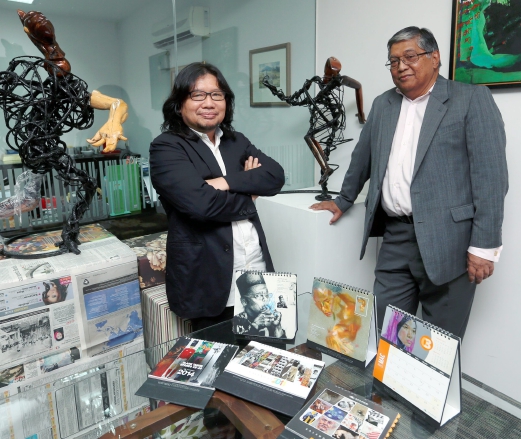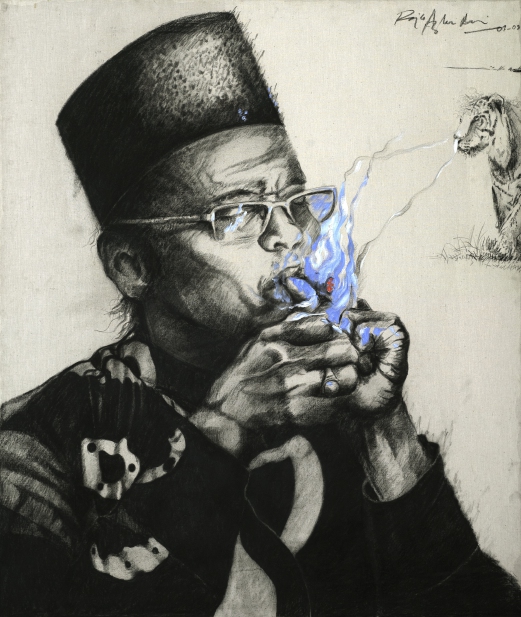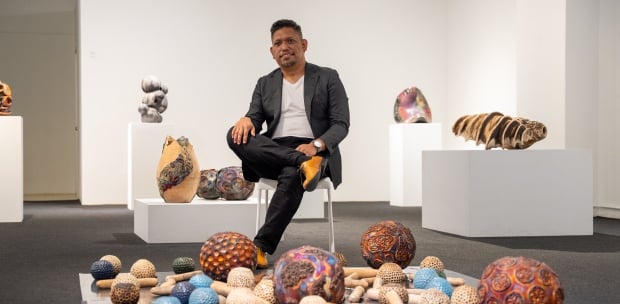CORPORATE philanthropy and the arts conveys the present scene of corporate backing for arts and culture. Within this embryonic framework of corporate philanthropy, many organisations deploy and support arts and cultural approaches to realise progressive change within their corporate social responsibility and/or corporate community involvement practices.
One such company is Spanco, Malaysia’s leading professional fleet management company, which for the past 12 years has produced its own calendar featuring local artists and their works.
The brainchild of CEO Datuk Hamzah Mohd Salleh and lawyer Pakhruddin Sulaiman, each year’s collection features works owned by both, and carries a different theme.

BEJEWELLED
Hamzah and Pakhruddin have enjoyed a long friendship. As the afternoon reaped into evening, both were retelling stories of “buying half of artist Yusof Ghani’s kitchen”, of friendly wars over art purchases, of Hamzah’s collection hijacked by his children, and his coveting a Syed Thajudeen painting.
Meanwhile, Pakha’s collection is immense, of which a fraction was seen by the public last year during the For The Imaginary Space show held at The Edge Galerie. His memory is eidetic, and he remembers every work acquired.
“Every year around August we’d get together and throw ideas around of what the next year’s calendar will be like. It’s wonderful to relax and talk art, which we can do for hours. This yearly calendar, which started with a modest one in 2004 has turned into something my clients look forward to, and our way of promoting local artists and their works,” Hamzah shares.

Spanco’s office is bejewelled with its CEO’s personal art collection. A rare Bayu Utomo work has prominence on one wall, Kow Leong Kiang’s portraits, Raja Azhar’s 2007 self-portrait Haru-Biru and Geiger-inspired sculptures which can literally kill you, are impressively displayed across the office’s expanse.
SELF-PORTRAITS
The 2016 edition features 12 artists and their self-portraits, each one penetrating and intriguing, a “gateway” into their complex minds. The artists are Bayu Utomo Radjikin, Fadilah Karim, Arif Fauzan, Raja Azhar Idris, Ahmad Fuad Osman, Samsudin Mohamad, Suddin Lappo, Arikwibowo Amril, Paiman, Noor Mahnun Mohamed, Zelin Seah and Amron Omar; and the paintings all belong to Pakha and wife Fati.
Arif Fauzan’s 2012 Grave Digger resonates deeply. The picture of him crossing the street immediately brings to mind The Beatles 1969 11th studio album cover for Abbey Road. Even the white VW Beetle is there.

Taken by photographer Iain Macmillan, the cover featured all four band members crossing an innocuous North London street, and the last, George Harrison as the grave-digger
in a faded grubby shirt and old, old tired denim, is one Arif’s portrait eerily resembles. They could be each other’s doppelgangers.
The artist reflects, saying: “It’s amusing how people read things. I wanted to do a simple recreation by whipping my face where George’s head was, paint in a few symbolisms around the work and manufacture my own conspiracy.”
I didn’t get a chance to ask the artist what the Beetle licence plates in his
painting meant — FTW 42IF as opposed to the actual plates LMW 28IF.

Fadilah Karim’s 2011 Nature #1 is another exceptional example. This shy chameleon is an artist many collectors are watching closely. Her works are nothing like her personality — they’re livewires of imploding electricity. Her self-portrait hints at a split personality, and who does one think of? The Two Fridas by Frida Kahlo.
Painted in 1939, the work is of two facades of the artist, completed after her divorce with artist Diego Rivera.
One shows her in traditional Tehuana costume, heart shattered and torn open, the main artery severed by surgical scissors.
She bleeds still, and waits for an end which would not come. Clasping her hands is the other Frida, a whole Frida with an intact heart,that part of her who yearns for a pain-free life.
Fadilah’s self-portrait suggests a similar feeling; the homochromatic hues, pinched expression, blank stare, and slashed strokes subtly hint of quiet desperation, the inner Fadilah screaming to be let out.

The rest are equally absorbing: Raja Azhar’s Haru-Biru (Helter-Skelter) intimates a difficult time in the artist’s life.
That blue smoke effect set against a sedate grey background is truly arresting.
Then, there’s Samsuddin Mohamad’s 1997 Potret Diri (Self-Portrait), of him looking far into the distance, with the ever so slight smirk; Zelin Seah’s 2013 dystopic/manic Don’t Make a Wave; Amron Omar’s 2004 semi-abstract Pertarungan (Battle) in warrior stance and Bayu Utomo’s 1999 Tanpa Tajuk (Without Title).
The last one has the artist glowering boldly at the world, at you, at me. As Oscar Wilde said, “Every portrait that is painted with feeling is a portrait of the artist, not of the sitter. The sitter is merely the accident, the occasion. It is not he who is revealedby the painter; it is rather the painter who, on the coloured canvas, reveals himself.”
HEADY VOYAGE
And speaking of calendars, The National Gallery London has two which stand out: the Impressionistwall calendar 2016 which takes viewers on a heady voyage through the Impressionist paintings from the National Gallery Collection. Expect to see Camille Pissarro’s 1870 Fox Hill, Upper Norwood, Paul Cezanne’s 1888 Avenue at Chantilly, Claude Monet’s 1878-81 Lavacourt under Snow, Pierre-Auguste Renoir’s 1889 Lakeside Landscape and Eugene Boudin’s 1888 The Entrance to Trouville Harbour.
And of course there’s the mad-genius Francisco Jose de Goya y Lucientes.
The Goya 2016 wall calendar features 1788 The Duke and Duchess of Osuna and their Children, 1783 Maria Teresa de Vallabriga y Rozas on Horseback and 1792-95 Self Portrait at an Easel.
In conclusion, here’s something by American author, poet and mystic Ella Wheeler Wilcox — A Man’s Last Love from The Kingdom of Love and Other Poems:
Like the tenth wave, that offers to the shore
Accumulated opulence and force,
So does my heart, which thought it loved of yore,
Carry increasing passion down the course
Of time to proffer thee.
Oh! not the faint
First ripple of the sea should be its pride,
But the great climax of its unrestraint,
Which culminates in one commanding tide.
The lesser billows of each crude emotion
Break on life’s strand, recede, and then unite
With love’s large sea; and to some late devotion
Unrecognised, they bring their lostdelight.
So all the vanished fancies of my past
Live yet in this one passion, grand and vast.




